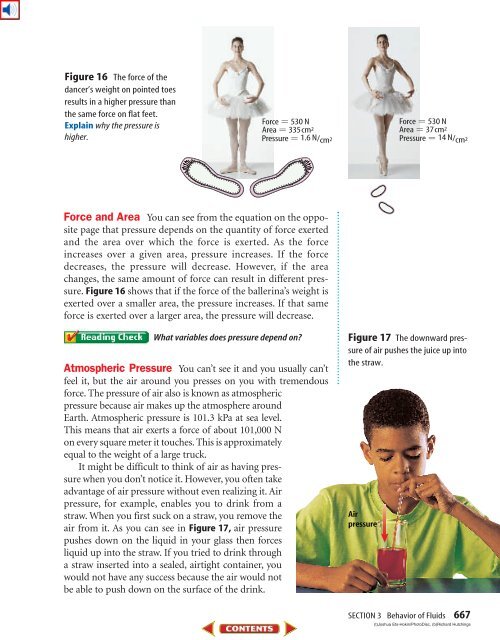You also want an ePaper? Increase the reach of your titles
YUMPU automatically turns print PDFs into web optimized ePapers that Google loves.
Figure 16 The force <strong>of</strong> the<br />
dancer’s weight on pointed toes<br />
results in a higher pressure than<br />
the same force on flat feet.<br />
Explain why the pressure is<br />
higher.<br />
Force 530 N<br />
Area 335 cm 2<br />
Pressure 1.6 N/cm 2<br />
Force and Area You can see from the equation on the opposite<br />
page that pressure depends on the quantity <strong>of</strong> force exerted<br />
and the area over which the force is exerted. As the force<br />
increases over a given area, pressure increases. If the force<br />
decreases, the pressure will decrease. However, if the area<br />
changes, the same amount <strong>of</strong> force can result in different pressure.<br />
Figure 16 shows that if the force <strong>of</strong> the ballerina’s weight is<br />
exerted over a smaller area, the pressure increases. If that same<br />
force is exerted over a larger area, the pressure will decrease.<br />
What variables does pressure depend on?<br />
Atmospheric Pressure You can’t see it and you usually can’t<br />
feel it, but the air around you presses on you with tremendous<br />
force. The pressure <strong>of</strong> air also is known as atmospheric<br />
pressure because air makes up the atmosphere around<br />
Earth. Atmospheric pressure is 101.3 kPa at sea level.<br />
This means that air exerts a force <strong>of</strong> about 101,000 N<br />
on every square meter it touches. This is approximately<br />
equal to the weight <strong>of</strong> a large truck.<br />
It might be difficult to think <strong>of</strong> air as having pressure<br />
when you don’t notice it. However, you <strong>of</strong>ten take<br />
advantage <strong>of</strong> air pressure without even realizing it. Air<br />
pressure, for example, enables you to drink from a<br />
straw. When you first suck on a straw, you remove the<br />
air from it. As you can see in Figure 17, air pressure<br />
pushes down on the liquid in your glass then forces<br />
liquid up into the straw. If you tried to drink through<br />
a straw inserted into a sealed, airtight container, you<br />
would not have any success because the air would not<br />
be able to push down on the surface <strong>of</strong> the drink.<br />
Force 530 N<br />
Area 37 cm 2<br />
Pressure 14 N/cm 2<br />
Figure 17 The downward pressure<br />
<strong>of</strong> air pushes the juice up into<br />
the straw.<br />
Air<br />
pressure<br />
SECTION 3 Behavior <strong>of</strong> Fluids 667<br />
(t)Joshua Ets-Hokin/PhotoDisc, (b)Richard Hutchings

















